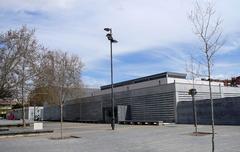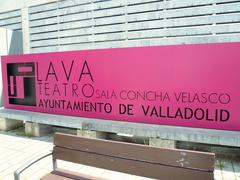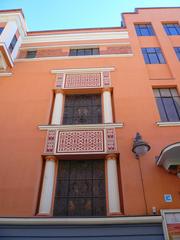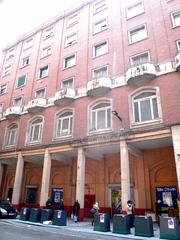
Paseo de Zorrilla Valladolid: Visiting Hours, Tickets, and Travel Guide
Date: 04/07/2025
Introduction to Paseo de Zorrilla in Valladolid
Paseo de Zorrilla is one of Valladolid’s most iconic avenues, celebrated for its seamless blend of historical heritage, vibrant urban life, and verdant green spaces. Spanning approximately 4 kilometers from the historic Plaza de Zorrilla to the city’s southern limits, this boulevard connects the medieval heart of Valladolid with its modern developments. Named in 1893 after José Zorrilla, the renowned Romantic poet and Valladolid native, the avenue encapsulates the city’s literary legacy and urban dynamism (Guide to Paseo de Zorrilla Visiting Hours and Valladolid Historical Sites).
Whether you’re drawn to 19th-century landmarks like the Academia de Caballería, modern shopping centers such as Centro Comercial Vallsur, or the tranquility of Campo Grande park, Paseo de Zorrilla offers a rich array of experiences. This guide provides detailed visitor information, including visiting hours, ticketing (where applicable), accessibility, cultural highlights, and practical tips. From event calendars to guided tours and gastronomy, you’ll find everything needed to make the most of your visit. For additional insights and interactive experiences, resources like Audiala and official tourism apps are invaluable (Nomads Travel Guide).
Table of Contents
- Introduction
- Origins and Historical Evolution
- Urban Development and Expansion
- Architectural and Cultural Landmarks
- Urban Development and Layout
- Green Spaces and Environmental Value
- Cultural Landmarks and Heritage
- Social and Commercial Life
- Integration with Valladolid’s Urban Identity
- Accessibility and Visitor Information
- Role in Valladolid’s Cultural Calendar
- Architectural and Artistic Highlights
- Urban Significance in Numbers
- Practical Visitor Information
- Exploring Paseo de Zorrilla: Visiting Hours, Attractions, and Tips
- Discover Paseo de Zorrilla Valladolid: Visiting Hours, Attractions, and Travel Tips
- FAQ
- Visual Highlights and Media
- Conclusion and Call to Action
- References and Further Reading
Origins and Historical Evolution
Originally, Paseo de Zorrilla followed ancient routes connecting Valladolid to Madrid, known historically as the “Camino Real Nuevo de Madrid” and “Camino Real Viejo de Madrid.” Over time, it has carried various names—Calle de Puente Duero and Acera de Sancti Spíritus among them—mirroring the city’s shifting urban landscape.
The avenue gained its current name in 1893, honoring the illustrious poet José Zorrilla, in keeping with a 19th-century tradition of immortalizing cultural figures through urban toponymy. This renaming underscored Valladolid’s literary pride and its role as a center of Spanish Romanticism.
Urban Development and Expansion
19th and Early 20th Century
The late 19th century marked a period of rapid expansion for Valladolid. Paseo de Zorrilla evolved from a peripheral road to a principal city artery, facilitating the growth of southern neighborhoods. Notable additions included the Academia de Caballería and the Hospital Militar, showcasing the era’s distinctive architecture and institutional presence.
Mid-20th Century Modernization
Mid-century urban reforms transformed Paseo de Zorrilla with broader lanes, landscaped medians, and pedestrian-friendly walkways. The construction of new residential blocks and commercial centers, along with the original Estadio José Zorrilla (prior to its relocation), further established the avenue as a hub for community gatherings and sporting events.
Contemporary Urban Landscape
Today, the avenue harmoniously combines historic architecture with modern amenities. The Puertas de Valladolid, a monumental gateway by Cristóbal Gabarrón at the southern end, symbolizes the city’s embrace of modernity. Nearby, Centro Comercial Avenida and Centro Comercial Vallsur offer shopping, dining, and entertainment, while Campo Grande park provides a lush urban oasis.
Architectural and Cultural Landmarks
Plaza de Zorrilla
This grand plaza marks the avenue’s northern gateway. Encircled by stately architecture, including the Academia de Caballería, Plaza de Zorrilla features a central monument to José Zorrilla and regularly hosts cultural events and social gatherings (valladolidparatodos.es).
Religious and Civic Buildings
Key sites along the avenue include the Iglesia de la Inmaculada Concepción and the Plaza de Toros, the latter remaining active for traditional festivities and major cultural events.
Urban Development and Layout
Paseo de Zorrilla exemplifies 19th- and 20th-century urban planning, with broad, tree-lined avenues and wide pedestrian walkways designed for accessibility and openness. The boulevard begins at Plaza de Zorrilla and stretches towards the Puente de Poniente, which crosses the Pisuerga River (Tourist Secrets). Along the way, visitors encounter a blend of neoclassical landmarks, such as Palacio de Pimentel (the seat of the Provincial Council), modern commercial buildings, and residential complexes.
Green Spaces and Environmental Value
A defining feature of Paseo de Zorrilla is its integration with green spaces. Campo Grande, covering 115,000 m², serves as Valladolid’s “green lung.” Established as a garden in 1787, its origins trace back to the 15th century. The park is renowned for its floral displays, ornamental lake, and diverse birdlife, including peacocks and other exotic species (Spain.info; Wikipedia). A striking floral coat of arms at its Plaza de Zorrilla entrance is a testament to the city’s gardening tradition.
Cultural Landmarks and Heritage
The avenue is dotted with significant cultural and historical sites. The Palacio de Pimentel appeals to those interested in political and architectural history (Tourist Secrets), while the Plaza de Toros stands as a 19th-century civic landmark and venue for festivals. The Puente de Poniente provides panoramic city views, reinforcing the avenue’s role as a connector between historic and modern Valladolid.
Social and Commercial Life
Lined with shops ranging from local artisan boutiques to international brands, Paseo de Zorrilla is a popular retail and leisure destination. Cafés and restaurants offer traditional Castilian dishes alongside contemporary options. Seasonal markets, street performances, and festivals regularly animate the boulevard, creating a lively social hub (Tourist Secrets).
Integration with Valladolid’s Urban Identity
Paseo de Zorrilla’s design reflects Valladolid’s commitment to harmonizing historical preservation with urban growth. Its proximity to iconic sites such as the Zorrilla House-Museum and Campo Grande, alongside governmental and educational institutions, cements its status as a cultural and civic axis (Spain.info).
Accessibility and Visitor Information
The avenue is fully wheelchair accessible, with ramps, smooth pavements, and public transportation via AUVASA bus lines. Taxis and rideshare options are abundant. Public restrooms are available in parks and shopping centers. There is no admission fee to stroll the avenue or visit Campo Grande; most attractions are open year-round, though individual venues may have specific hours.
Role in Valladolid’s Cultural Calendar
Paseo de Zorrilla hosts traditional processions, open-air concerts, and festivals such as Semana Santa and the Valladolid International Film Festival (Seminci). Notable annual events include the Pingüinos Motorcycle Rally in January, the Feria y Fiestas de la Virgen de San Lorenzo in September, and the Marcha Contra el Cáncer in October (valladolidparatodos.es).
Architectural and Artistic Highlights
The avenue’s architecture is a visual narrative of Valladolid’s evolution, mixing neoclassical facades, modernist elements, and contemporary public art installations. The floral coat of arms at Campo Grande’s entrance is a highlight of local horticultural artistry (Spain.info).
Urban Significance in Numbers
- Length: Approximately 4 kilometers.
- Campo Grande park: 115,000 m²—the city’s largest green space (Wikipedia).
- Plaza de Toros: Hosts thousands during major events.
- Commercial density: Dozens of shops, cafés, and restaurants.
Practical Visitor Information
Visiting Hours and Tickets
- Paseo de Zorrilla: Open 24/7; no entry fee.
- Campo Grande Park: Open daily, typically from 7:00 to 22:00 (seasonal variation).
- Shopping Centers: Centro Comercial Vallsur and Avenida, 10:00–22:00.
- Historic Sites: Check individual websites for ticketing and hours.
Accessibility
- Wheelchair-accessible sidewalks and park entrances.
- Multiple AUVASA bus lines serve the avenue.
- Bike rentals and dedicated cycling lanes available.
Guided Tours and Special Events
Official tourism offices and local agencies offer guided walking tours featuring Paseo de Zorrilla and surrounding historical sites. Check event calendars for festivals and parades.
Photography and Visitor Tips
- Best time to visit: Spring and autumn for mild weather.
- Photography: Sunset and golden hour provide optimal lighting.
- Local experiences: Sample Castilian cuisine at avenue cafés and terraces.
Exploring Paseo de Zorrilla: Visiting Hours, Attractions, and Tips
Paseo de Zorrilla is ideal for walking at any time, with wide sidewalks and leafy medians. Noteworthy attractions include:
- AC Hotel Palacio de Santa Ana: Luxury hotel in a restored 18th-century monastery (Nomads Travel Guide).
- Centro Comercial Vallsur: Major shopping hub, 10:00–22:00 (Nomads Travel Guide).
- Campo Grande Park: Free entry, open from early morning to late evening.
- Teatro Zorrilla: Historic theater hosting performances, with ticket prices varying by event.
Nearby, parks like Las Moreras provide riverside walks, and key landmarks such as Plaza Mayor, Valladolid Cathedral, and the National Sculpture Museum are easily reached by foot or bus.
Discover Paseo de Zorrilla Valladolid: Visiting Hours, Attractions, and Travel Tips
Visiting Hours and Ticket Information
Paseo de Zorrilla is always open to visitors. Shops and cafés generally open from 10:00 to 14:00 and 17:00 to 21:00, with larger stores operating all day. Cultural venues may have separate entry fees and hours; always check official sources before visiting.
Strolling the Paseo de Zorrilla
The avenue’s tree-shaded walkways and lively squares offer a relaxed atmosphere, especially in the mornings and evenings. During festivals, the boulevard is filled with parades, concerts, and open-air markets (thegoguy.com).
Key Attractions
- Plaza de Zorrilla: Statue of José Zorrilla and ornate fountain (valladolidparatodos.es).
- Campo Grande: Tranquil park with lakes and sculptures (thecrazytourist.com).
- Shopping: El Corte Inglés and local boutiques.
- Gastronomy: Tapas bars and traditional Castilian restaurants (thegoguy.com).
Cultural and Historical Sites
- Academia de Caballería: 19th-century cavalry academy.
- Plaza de Toros: Venue for concerts and cultural events.
- Antiguo Hospital Militar: Historic architectural site.
- Plaza Juan de Austria: Community gathering square (topvalladolid.com).
Modern Developments
The transformation of the former Matadero into the Factoría de Creación cultural hub is expected to be completed in 2025 (elnortedecastilla.es).
Practical Tips for Visitors
- Getting there: Easily accessible by foot, bike, or public transport.
- Parking: Underground and street parking available but limited during events.
- Accessibility: Wide, level sidewalks and ramps; accessible bus stops.
- Safety: Well-lit and monitored; standard precautions apply.
- Language: Basic Spanish useful; some English spoken in tourist areas.
Frequently Asked Questions (FAQ)
Q: Are tickets required to visit Paseo de Zorrilla or Campo Grande?
A: No, both are public spaces with free entry. Some museums and special exhibitions may charge admission.
Q: What are the opening hours for shops and restaurants?
A: Most operate from 10:00 to 14:00 and 17:00 to 21:00; larger centers remain open throughout the day.
Q: Is the avenue accessible for wheelchairs and strollers?
A: Yes, with ramps and wide sidewalks throughout.
Q: Are guided tours available?
A: Yes, via local agencies and the official tourism office.
Visual Highlights and Media
Alt tags such as “Paseo de Zorrilla visiting hours” and “Valladolid historical sites” are recommended for SEO.
Conclusion and Call to Action
Paseo de Zorrilla is a vibrant showcase of Valladolid’s history, culture, and urban vitality. Its architectural gems, lush parks, bustling shops, and lively events ensure there’s something for every visitor. Plan your trip by consulting the official Valladolid tourism website for current schedules and events, and download the Audiala app for guided tours and insider tips. Stay connected via social media for the latest updates.
Internal and External Resources
- Official Valladolid Tourism Website
- Spain.info
- Tourist Secrets
- Nomads Travel Guide
- Valladolid Para Todos
- El Norte de Castilla
- Top Valladolid
- The Go Guy
- The Crazy Tourist
References and Further Reading
- Guide to Paseo de Zorrilla Visiting Hours and Valladolid Historical Sites: A Complete Visitor’s Guide, 2025, Valladolid City Council (https://www.turismovalladolid.com)
- Paseo de Zorrilla: Visiting Hours, Tickets, and Valladolid Historical Sites Guide, 2025, Tourist Secrets (https://www.touristsecrets.com/destinations/europe/spain/how-to-spend-a-weekend-in-valladolid-spain-things-to-do/)
- Exploring Paseo de Zorrilla: Visiting Hours, Attractions, and Tips for Valladolid’s Historic Avenue, 2025, Nomads Travel Guide (https://www.nomads-travel-guide.com/city/valladolid/)
- Paseo de Zorrilla Valladolid: Visiting Hours, Attractions, and Travel Tips, 2025, Valladolid Para Todos (https://www.valladolidparatodos.es/plaza-de-zorrilla/)
- Campo Grande Park Information, 2025, Spain.info (https://www.spain.info/en/places-of-interest/campo-grande/)
- Valladolid Urban Development and Cultural Events, 2025, El Norte de Castilla (https://www.elnortedecastilla.es/valladolid/contenedor-cultural-remata-transformacion-matadero-zorrilla-anos-20250602064032-nt.html)















